17 Big Ideas to Make Philly a Kid-Friendly City

Sister Cities Park is a glowing example of kid-friendly city planning in Philly. / Photograph by Matt Stanley for Center City District
Eleven summers ago, the Center City District unveiled a newly renovated Sister Cities Park. Embedded in the midst of the buzzing Ben Franklin Parkway, the once-barren swath of land was now an oasis, a wholesome slice of urban utopia that included a pond-like pool, a rocky climbing embankment, benches and tables, geysers bursting from smooth bluestone pavement, a cafe with restrooms, stroller parking, and a soft, expansive lawn. Now, every summer, you see children there from all over the city, running free and playing together, and adults of all stripes, too — some watching the kids, some sipping drinks, some spreading blankets in front of the musicians who pop up to play under sherbet skies.
It is, for my money, the most magical place in Philadelphia.
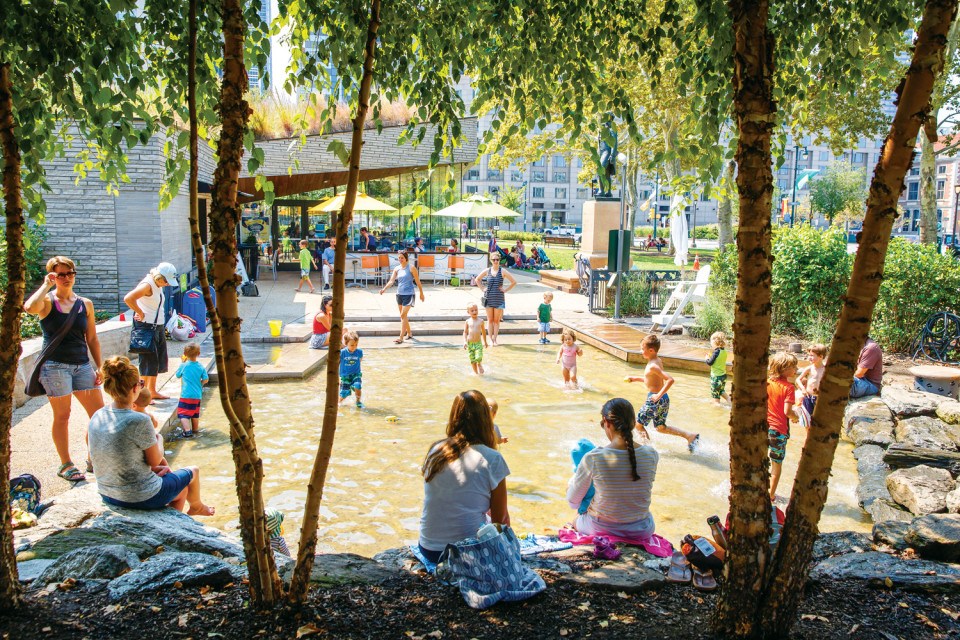
The shaded, seating-filled “pond” at Sister Cities Park, a multi-generational gathering space / Photograph by Matt Stanley for Center City District
This is an astounding stance to take, maybe, in a town that also includes the room where the Declaration of Independence was signed. I stand by it, though, in large part because of the feeling I get when I’m at Sister Cities — pride in Philly and its people, yes, but also a profound sense of “feeling okay as a caregiver,” as Meghan Talarowski recently put it.
Talarowski is a renowned play researcher and playscape architect and the head of Philly-based Studio Ludo, the design firm behind the forthcoming Anna C. Verna Playground in FDR Park, among others nationwide. When she used that language — feeling okay as a caregiver — she was referencing time she spent as a parent in London, where she could roll a stroller right into a black taxi or a bus, where museums had breastfeeding spaces and calm-down rooms, where the plentiful playgrounds all had coffee shops. This was a city, as Talarowski says, that was “investing in people.”
As both a city dweller and a parent, this resonates with me. To be taken care of in these ways, to have your own basic needs met so that you can in turn meet the needs of a child, and, more crucially, to see your kids safe and cared for and engaged in the place where they live — these are not small things. They are, however, often the result of an aggregation of small things — like, say, the rubberized posts (a.k.a. bollards) that keep cars away from crosswalks, a shade tree at a park, a mini library at a laundromat. (And okay, yes — sometimes it’s also very big things, like a $5 million park.) Keep reading …
1.
Appoint a Children’s Mayor
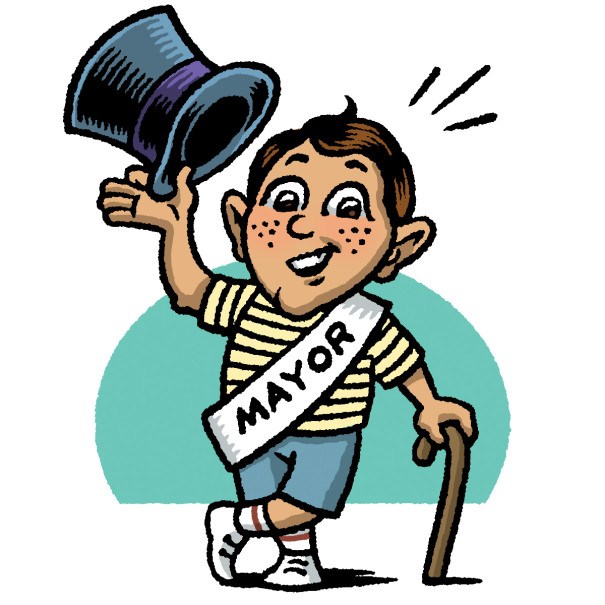
Illustration by Mario Zucca
In 2020, Mayor Kenney created a new city office to better coordinate more of our city’s child-focused departments and programs, boosting their efficiency and effectiveness: The Office of Children and Families, run by deputy mayor Vanessa Garrett Harley, currently oversees our Department of Human Services, the city’s pre-K program, community schools, the city’s Work Ready program for youth, the Free Library and Parks & Rec. In short? It’s a very big job.
Now, hear us out: What if we went even bigger?
This is the dream of Meghan Talarowski, renowned playground designer, play researcher, and the founding executive director of Philly-based Studio Ludo. A Philadelphia Children’s Mayor, she says, would “advocate for childhood” in an even more sweeping fashion — part visionary, part connector, part agitator whose mission is to “put children’s needs at the forefront” across all the moving parts of this city. An advocate whose raison d’être is to make Philly the greatest city it can be — safe, fun, full of opportunity — for its children.
With the help of an expert children’s cabinet, our Children’s Mayor might, for example, articulate and push a three-year vision for street safety near schools and along our most accident-prone corridors. A Children’s Mayor might require child-focused considerations like parklets or green spaces for every new development project (hey, see number 16!), or help broker public-private cross-pollination with, say, our professional sports teams, to help fund, run and provide supplies for after-school programming. Or … well, there’s no shortage of ideas and opportunities in this city. Let’s create the muscle to push some through.
2.
Buy Local

Climbable, sittable, playable bike racks! / Photograph courtesy of Tiny WPA
We’re talking to you, City of Philadelphia, and we’re talking specifically about these climbable, sittable, playable bike racks made by Philadelphia teens through the Tiny WPA, a nonprofit that works with young people to design and build items that serve and improve their community. “Why should Philly buy a bike rack made in China,” asks Tiny WPA co-founder Alex Gilliam, “when we can make them here and teach our young people?” Talk about a virtuous cycle: Philly could contract with Tiny WPA for bike racks (well, the racks for starters — they build other stuff, too!), which would give our young future-change agents creative technical skills and workforce training as they in turn would give us useful, playful urban infrastructure that serves both kids and adults all over the city. Win-win-win.
3.
Free the Internet
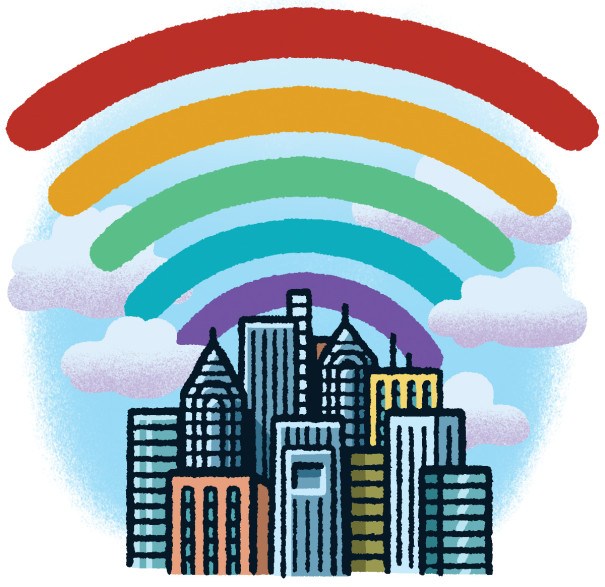
Illustration by Mario Zucca
When the pandemic closed classrooms and forced Philly kids to learn from their kitchen tables, Comcast stepped in to help provide free and subsidized internet in conjunction with the city’s PHLConnectED program. The sponsored service ends this month, sending families into the morass of the feds’ Affordable Connectivity Program, which provides a discount of up to $30 per month for eligible households. Only 49 percent of eligible Philadelphians currently take advantage of this benefit, leaving more than 147,000 households paying more than they need to. What if the country’s largest internet provider — worth $170 billion — partnered in perpetuity with our school district to provide the vital learning tool of connectivity at no cost to eligible families? SDP + Comcast = ConnectED forever!
4.
Clean It and Green It
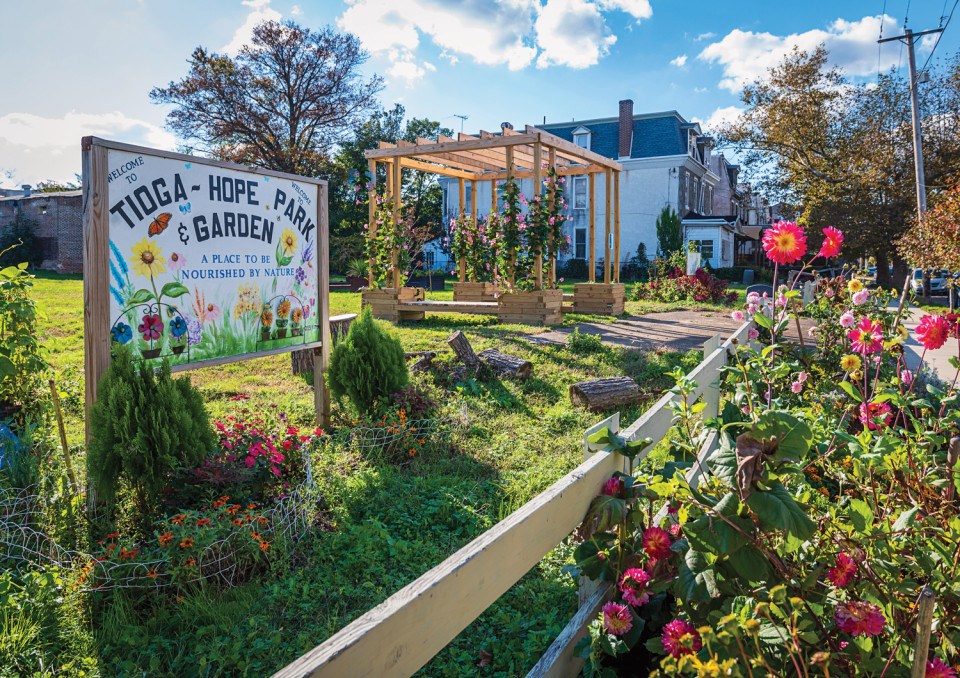
Tioga-Hope Park & Garden in North Philly / Photograph by Rob Cardillo
Research by HUP emergency-room physician Eugenia South has shown that fixing up vacant houses, cleaning empty lots, and planting shrubs, trees and flowers has far-reaching effects on residents, including our kids — it leads to less gun violence, reduced drug use, increased socialization, even lowered heart rates. South has made it her mission to spread that message throughout the city, directing Penn’s Urban Health Lab and working with the Pennsylvania Horticultural Society and the Deeply Rooted collab to bring the benefits of “tree equity” and curbside marigolds to underserved neighborhoods. As CHOP president Madeline Bell has noted, “Children who grow up with access to green spaces and trees are more likely to lead healthier lives free of conditions like asthma and obesity.” And all kids, Dr. South says, deserve to stop and smell the roses: “When you turn a space from blight to well-maintained, it’s evidence that care is happening.” We can all help with this effort: To report a vacant home or empty-lot eyesore, call 311; to join in community cleanups, get a FREE street tree, become a Tree Tender, join or start a community garden and more, contact PHS or Deeply Rooted.
5.
More Play in More Places for More People
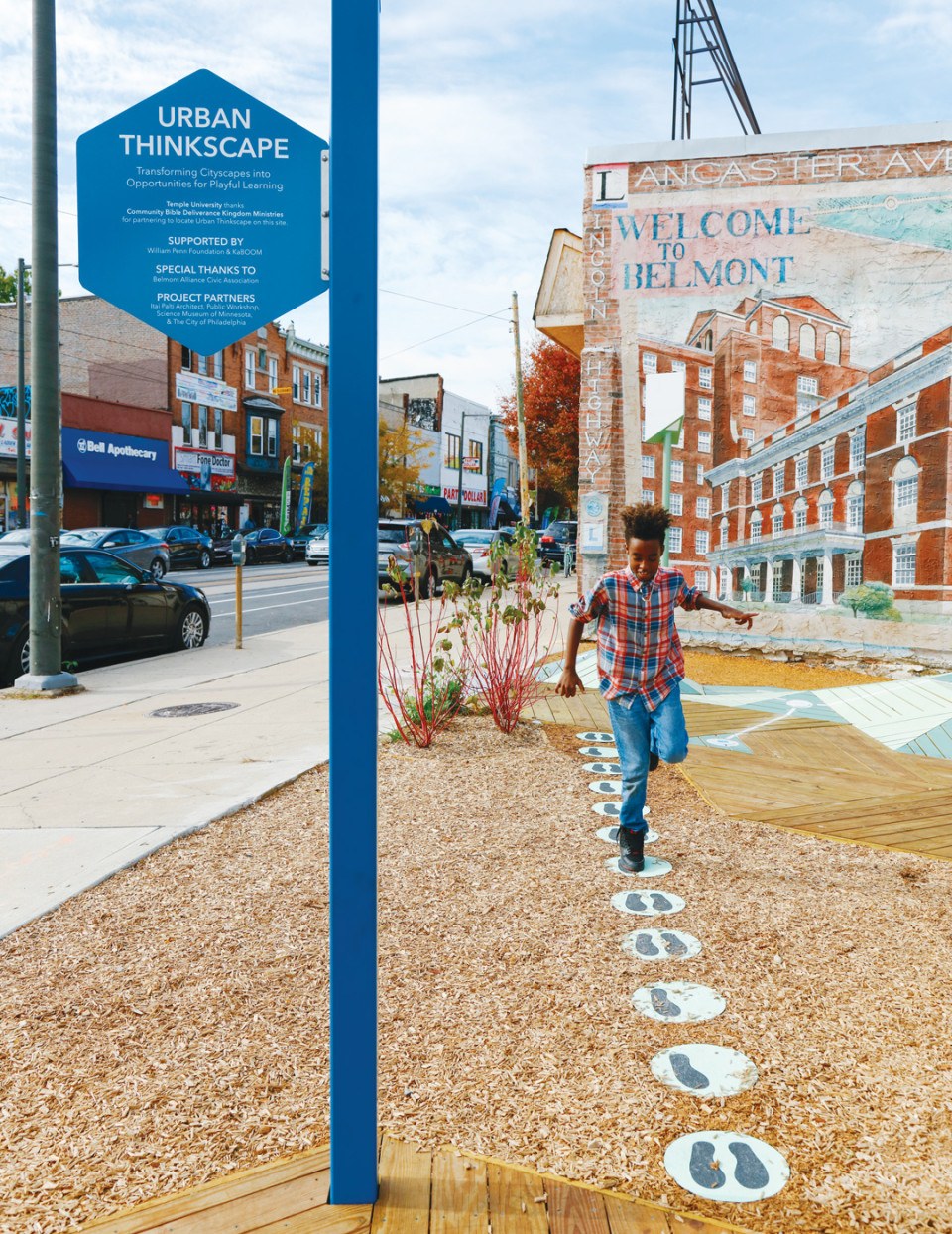
The Urban Thinkscape in West Philly’s Belmont neighborhood / Photograph by Sahar Coston-Hardy
It’s serious business, play — linked to helping kids grow learning skills, resilient behaviors, social-emotional health, cooperation and more. (This is true for adults, too!) When we talk about creating a more playful Philly, it isn’t just that we could use more and better playgrounds in parts of our city — though we can; a recent study from the play-equity-focused nonprofit Kaboom reported that one-third of the census tracts in Philly don’t have playgrounds. It’s also that when we think about play, we shouldn’t only consider children … and we shouldn’t only consider playgrounds.
On that first point, says play researcher Meghan Talarowski, half of the people in any playground aren’t children, but caregivers — and “we need to take care of those people.” Benches, restrooms, lines of sight, food and drink — these sorts of comforts help caregivers actually want to go to the playground, she’ll tell you, which makes for more and better time spent playing. And adding elements that let everyone (teens, adults, seniors) play and engage with the space — simple exercise equipment, programming, comfortable hang space — creates oases that serve everyone, both in the short and long term.
That’s the power of well-designed public space, Talarowski says: “There’s a real lack of trust in society today. Spaces where people of all ages and backgrounds are playing together help create the social cohesion we need.”
To this end, she’s excited about the new Anna C. Verna Playground she’s working on at FDR Park, opening later this year. The playground will be adjacent to a welcome center with bathrooms and a cafe and include three enclosed treehouses with climbing nets and tall slides (tall because risky play is good for kids, but enclosed because, unlike in Europe, where risk playgrounds are all the rage, “We don’t have the safety net of universal health care!”), plus a giant swing set — the biggest in America, with 30 swings. “Our research,” says Talarowski, “shows people of all ages love to swing!”
Here’s the other thing about upping our play quotient: We can also go much (much!) smaller, says Kathy Hirsh-Pasek, the Temple psychology professor who co-founded the Playful Learning Landscapes initiative (PLL) to “infuse the science of learning to help build strong cities.” She wants to foster learning and social connection in environments kids encounter in everyday life. For example? PLL’s 2018 Urban Thinkscape project worked with the Belmont Civic Association in West Philly to transform a plain-Jane bus-stop area into an educational play space featuring a puzzle with moveable parts, a rubberized hopscotch pad, and an art installation with hidden figures. In the immediate aftermath? Studies showed more families interacting and more community members invested in keeping the space tidy.
There are, Hirsh-Pasek adds, loads of examples of everyday play like this in Philly — the Playful Learning Landscapes Action Network regularly collaborates with groups across the city to make more moments of play, from interactive chalk walls to signs posted in supermarkets designed to spur conversation between kids and their adults to literacy games painted on subway walls. Other cities, meantime, have piloted innovations like maps and running tracks painted on sidewalks and musical instruments planted at bus stops. And why shouldn’t we all play on them? The more moments of fun we can create, the better. It’s science. — C.S.L.
6.
Make our Streets Safer …
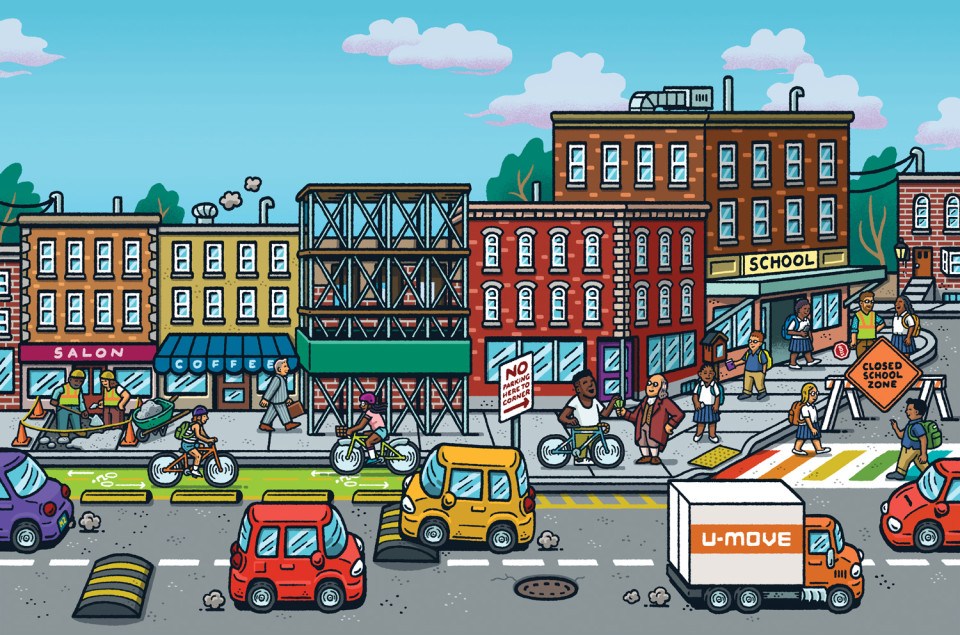
/ Illustration by Mario Zucca
In the early 1970s, the people of the Netherlands had had enough: Too many fellow citizens — 3,300 a year, 500 of them children — were dying in traffic-related accidents. So they took to the streets, literally. Their Stop de Kindermoord (“Stop child murder”) movement pushed through a transportation transformation that saw traffic fatality rates go from 245 per million people to 34 per million by 2019.
In more than one way, we’d do well to channel the Dutch now in Philly, a city where so many streets feel like the Wild West — where more than 120 people died in traffic fatalities last year, and police answer 40 hit-and-run calls a day.
Of course, safe streets aren’t just for kids and the people who are raising them. But there’s wisdom in considering mobility from a child’s perspective, says Andrew Stober. He spent years running Philly’s Department of Transportation and Utilities, and he’s currently in the private sector, working on transportation with cities around the world. He points to the mobility-focused 8 80 Cities Initiative, which operates on the premise that a city planned for eight-year-olds and 80-year-olds will be the best city for all people — more inclusive, more equitable, safer, more active. And not for nothing, Stober adds, Philly’s population of 80-year-olds with similar mobility needs to those of children and families is going to grow substantially in coming decades.
So … what might better look like for us? Keep reading …
7.
… And More Flexible
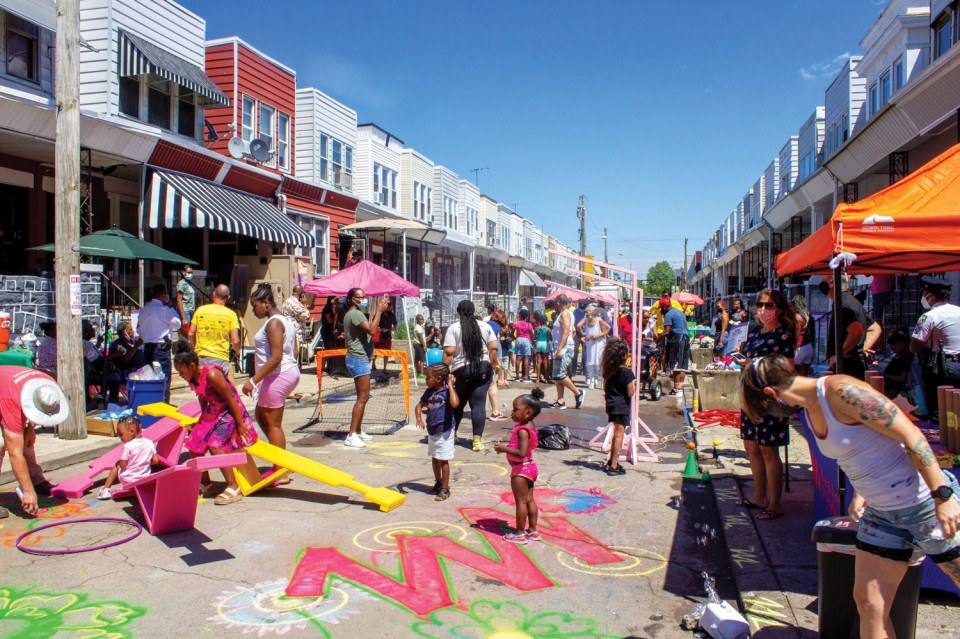
Playstreets joy on one West Philly block / Photograph by Joe O’Connor
As anyone who regularly traverses it knows, 9th Street as it runs through the Italian Market is chaos. The 47M bus squeezes its way north, mirrors grazing towers of tomato boxes. Drivers with Jersey plates inch along, desperate to find a spot that doesn’t require them to remember how to parallel-park.
But every year, for one magical May weekend, that all disappears, replaced by flat-tops sizzling with sausage, kids zipping through the crowd on scooters, parents relaxing with their second (or third) Peronis. The Italian Market Festival closes the stretch from Wharton to South — nearly three-quarters of a mile of street and endless miles of possibility.
Philadelphia dabbles in the concept of open and play streets, places where — either permanently or temporarily — the street is given over to the pedestrians, strollers and scooters usually relegated to sidewalks. There were Sansom Street and the MLK Drive during the pandemic, for instance; there’s also the city’s fantastic summer Playstreets program, which shuts down select streets for a day of food and neighborhood fun. These are micro-examples of what can be achieved when we don’t allow cars to dominate the transportation conversation. We can — and should — do more of this. Keep reading …
8.
Let Our People Go!

A “Portland Loo” modular bathroom / Photograph by Robert K. Chin/Alamy
Bathroom deserts in this city are real … and as most parents can tell you, in graphic detail, are really stressful at times. But we know that frantic, weepy, messy searches for facilities aren’t an inevitability of urban life, says Adam Benforado, Drexel law professor and author of A Minor Revolution: How Prioritizing Kids Benefits Us All: “Other places all around the world just have public bathrooms.” As it happens, Philly is working on it. This summer, the city launched its first “Portland Loo” — a modular, graffiti-proof, easy-to-clean bathroom big enough for a stroller and changing station — across from LOVE Park. Five more will pop up in other neighborhoods over the next few years, including one in Fotterall Square in North Philly. Ideally, we’d see six dozen of these things installed in much shorter order near parks and public spaces where people gather. And in the meantime? Let’s invest in offering better access to the existing bathrooms in our rec centers and municipal buildings scattered about the city.
9.
Get Real About Equity in High Schools
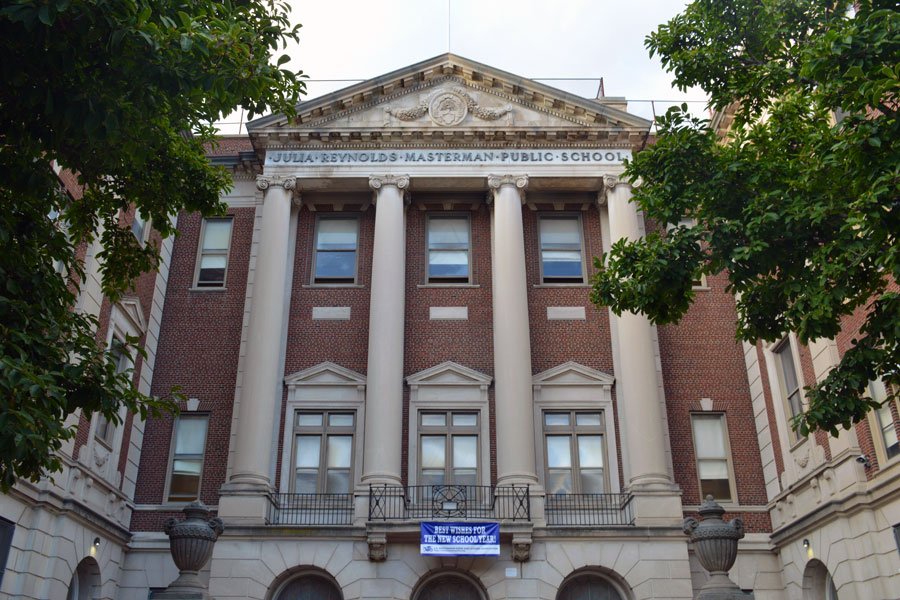
Masterman, one of Philadelphia’s special-admission high schools / Photograph by Michael Stokes/Flickr
My nine-year-old daughter took her PSSAs — the state’s assessment tests — for the first time this past spring. She was anxious, so I assured her they didn’t measure anything. I’d long since learned to avoid the parents who start mentioning Masterman in kindergarten. (It’s an excellent school, but how can you know it’s your five-year-old’s destiny?) But I’m still acutely aware we’re in a district that treats public high-school admission like The Hunger Games and uses PSSA scores as a factor. The school district’s 2021 changes to the admissions process, including a zip-code-based lottery, were designed to help improve equity in schools like Masterman, whose demographics look nothing like those of our city. And while this is a much-needed change, I can’t help but feel we’re being gaslit. Not every kid will thrive in one of the handful of “special” high schools, and kids who don’t make the cut for one reason or another still deserve all the opportunities the special-admits offer. Why have we left our neighborhood schools out of the conversation? Public high schools in our collar counties can provide a great education on a large scale, from “average” to AP students — I know; I went to one. Central and Masterman will be just fine; if we’re really interested in equity, let’s make sure all Philly teens have access to the extracurriculars and education they need to thrive — and that their proficiency on standardized tests when they’re children doesn’t determine their future. — L.S.
10.
Build Housing to Support Families
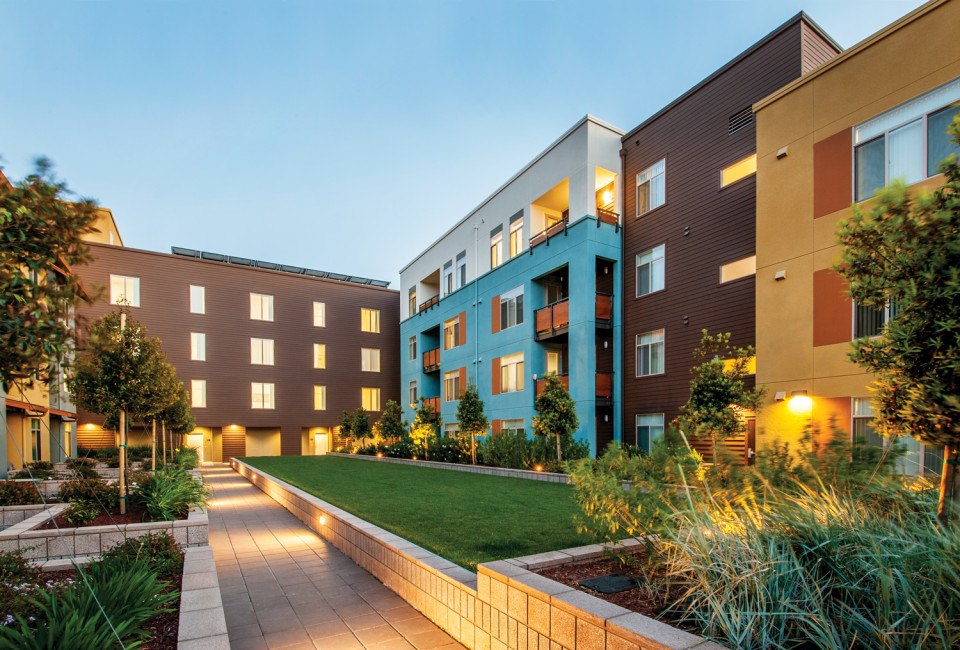
Multi-generational housing / Photograph by Alacatr/Getty Images
In family-friendly Stockholm, one of the things that stood out to urban anthropologist Katrina Johnston-Zimmerman was a noticeably community-oriented approach to multi-generational housing — “four- and five-story buildings with different kinds of units inside, a shared courtyard, a play space, gardens, a firepit situation, even a rug-beating station,” she says. And a setup like this is just one (tempting!) vision for housing that can help sustain and support families, says Diana Lind, urban policy specialist and author of Brave New Home: Our Future in Smarter, Simpler, Happier Housing; there are other options, too. It’s just that Philly’s zoning codes rarely offer the flexibility we might need to build, say, duplexes that allow generations of families to live side by side, or so-called “accessory dwelling units” (a.k.a. tiny homes, in-law-suites and basement apartments) that help big families comfortably live together and care for one another. We should loosen the codes, incentivize builders, and open up housing possibilities for more families.
11.
Prioritize Social-Emotional Programming
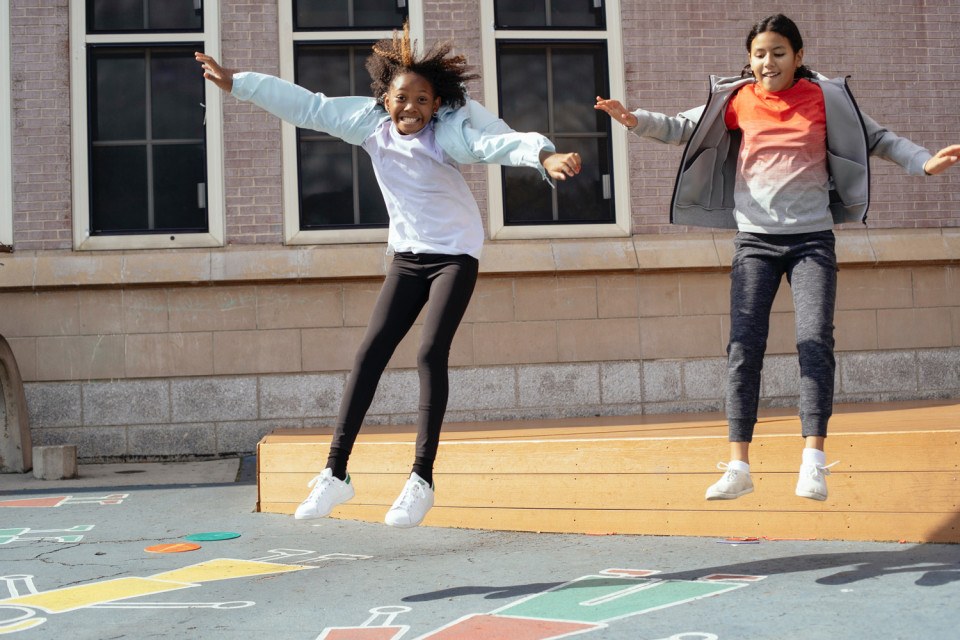
Photograph by Mary Taylor
Kurk Watson thinks we haven’t seen the full effects of the pandemic on our kids yet — but already, he says, we know that the isolation, regression and even trauma of the COVID years have created a need for them to rebuild some social skills. This is exactly what he does — teaches kids coping and growth skills through his organization, OPEXPark.
OPEXPark (it’s short for “opportunities and experiences”) isn’t a park at all, but rather a series of in-school programs run by Watson and his team — everything from drama to Ultimate Frisbee to fashion design — as a way to impart social-emotional competency to students. What does that mean? As the kids are acting and playing and designing, they’re also developing social skills like problem-solving and conflict resolution. Research has shown that intentional instruction in these areas leads to better academic achievement and decreased likelihood of criminality, poverty, and interpersonal conflict; one 2015 study in the American Journal of Public Health found that children who receive such support in early childhood were also less likely to experience substance abuse or mental health issues through early adulthood — problems on the rise since COVID.
Watson isn’t alone in his mission; there are other Philly organizations — like playtime-focused Playworks, where he got his start, and another group called Give and Go Athletics — that also work in some of our schools to teach play-based lessons in social skills, anti-bullying and school safety.
And it’s not just kids who need that social-emotional support, says Watson; educators deserve professional development that prioritizes social-emotional learning, too. “The child already has the tools; we just need to show them how to use the tools to build what’s necessary. They’re already capable of doing it,” Watson says. What must come next, he thinks, is a wider embrace of this sort of social-emotional programming in all schools, for all kids, with all curricula — not as an “extra” or a temporary fix, but as a built-in public-health mandate for raising healthy humans and citizens. — L.S.
12.
Transform Schools into Community Hubs
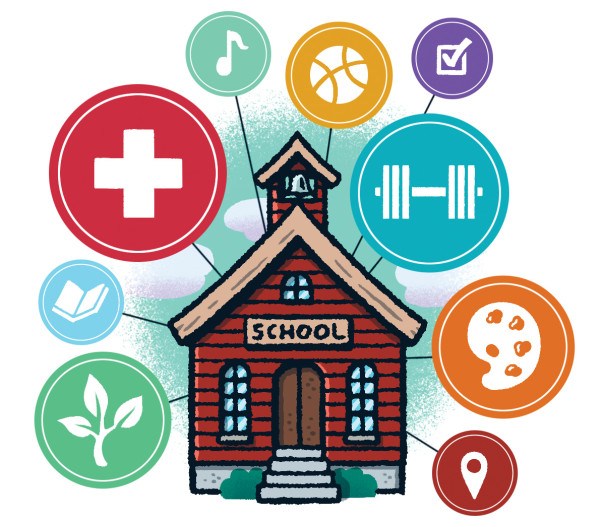
Illustration by Mario Zucca
“I’d love for the next administration to think much more ambitiously about what our school buildings — the actual buildings — could provide to our communities,” Diana Lind says. “Why not bring in our private sector — doctors and therapists and gyms — and also community gardens and other various things, so that our schools are these prized neighborhood possessions? There’s equity in the fact that they’re all in neighborhoods — they’re everywhere — and if we could reimagine them as places not just where kids go to school, but as entire community hubs? That would be amazing.”
13.
Make Transit Truly Easy
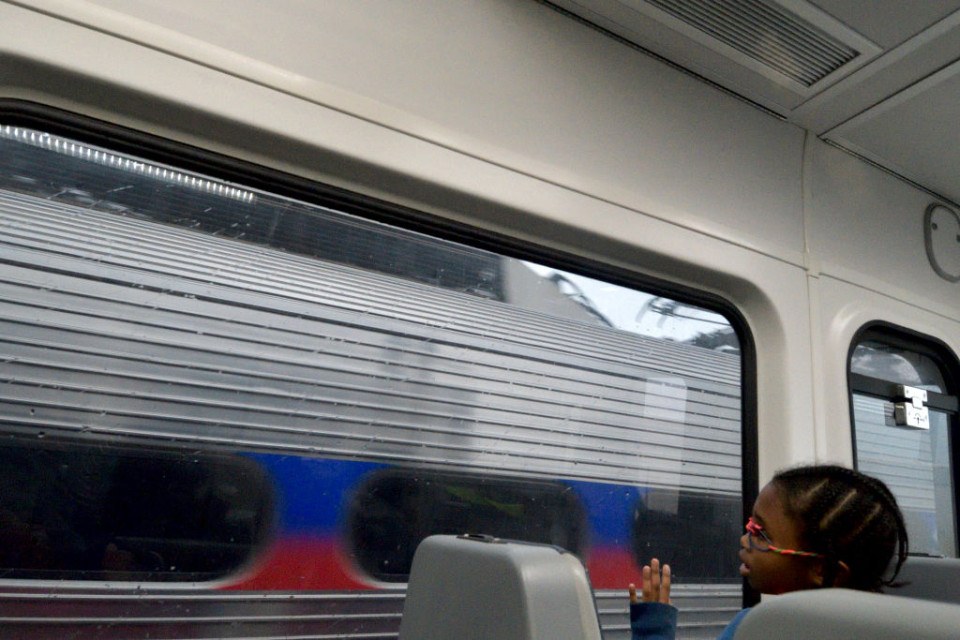
Boy looks out the window as an other SEPTA commuter Regional Rail train passes by. / Photograph by Bastiaan Slabbers/NurPhoto via Getty Images
Because access is everything. Here, a handful of family-forward transit transformations. Keep reading …
14.
Give Our Big Kids a Place to Be

Paine’s Park / Photograph by M. Edlow for Visit Philadelphia
This past April, the Fashion District mall imposed a 2 p.m. curfew on “unaccompanied minors.” A South Philly carnival banned minors just after that. Walk around Center City, and you’ll see posters in storefronts to the same effect: Liberty Place sets its “curfew” at 1 p.m., while a nearby Chestnut Street shop’s sign simply says, “No school kids allowed without parents.”
An overall sense of wariness toward young people in this city, combined with a lack of investment in our public spaces — as the Inquirer recently noted, Philly spends $73 per capita on parks and rec, vs. the national average of $98 — means there aren’t a lot of places for teenagers to just safely exist in Philadelphia. This needs to change. “We have an opportunity to really hug them instead of pushing this generation away,” says Tyrique Glasgow, who runs the Young Chances Foundation, which works with residents impacted by gun violence. “Not having the support — not from elected officials, not from your family, not from your community or the media — is something they have to deal with every day.” The answer, he says, is asking, “How we can address this in a collective way?” Keep reading …
15.
Employ Child-Impact Reports
Whenever we want to adopt some new law or regulation, Adam Benforado advises, “We should think about — formally go about assessing — how it’s going to impact children.” For example? “What would happen if we reduced the number of lanes on the Parkway? Is this a good or bad thing? What would happen if we increased property assessments? Good or bad for kids? What would happen if we raised minimum wage for people?” Often, he says, children are afterthoughts in these types of decisions, “because they don’t have a voice.” But in many areas of Europe, he says, such assessments are standard — just “a core part of good governance.”
16.
Ask Developers for More Than Just Parking
Philly often builds in parking requisites for new construction. That’s understandable — but, notes Adam Benforado, “Cars are often the problem for city kids, not the solution.” If we’re thinking solutions, why not also (or alternately) build in requisites for green space or community gardens? (See number 4!) Skate parks! Parklets! Playgrounds!
17.
More of These, Please

Craft Hall in Northern Liberties / Photograph by Jeff Fusco
When it comes to making Philly a great place to raise (and to be) children, our government, neighborhoods, nonprofits, even private businesses have already done a lot of work, particularly over the past decade. You can see the fruits of this labor in a hundred different ways, in neighborhoods all over the city. A next smart step? Stealing, sharing and scaling some of the best ideas. We’re not talking about those hyper-accessible mega-destinations too big, too perfect or too singular to realistically replicate. (Smith Memorial Playground, that free wooded play haven that draws kids from all over the city, comes to mind. Ditto Dilworth Park, and the magical stretch of parks along the Delaware River waterfront.) These are the unicorn opportunities. Instead, maybe we think about spots like Hunting Park’s Lil’ Philly Safety Village, a Studio Ludo-designed child-size “traffic park” with crosswalks, bike lanes and traffic signs, created to help kids learn street safety while they play. Youth Fab Philly and the Philadelphia Bicycle Coalition even provide “play ambassadors” on Saturdays to teach kids and loan bicycles. Then there’s the super-cool Philly Pump Track — Parkside’s hilly, adventure-focused bike park, complete with loaner bikes. (The Inky’s Helen Ubiñas has suggested scaling this idea up for dirt bikes and ATVs — a compelling idea in a city struggling to keep these vehicles off our streets.) Or — this one’s for you, restaurateurs! — Craft Hall, the family-friendly sports bar in No Libs with an arcade and indoor playground. Or the 10-foot climbing wall inside North Philly’s Cecil B. Moore Library. Who wouldn’t want that in their neighborhood?
Published as “17 Great Ideas for Small Philadelphians (and big ones, too!) in the July 2023 issue of Philadelphia magazine.